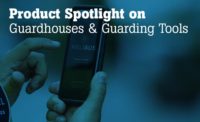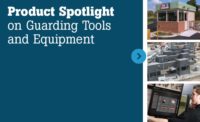Security officers are generally regarded as the face of security. Officers present a professional appearance at company entrances, patrol and tour facilities and grounds. But without tools, how effective is that officer? What value is a security officer’s presence bringing to the organization? And when cutbacks hit an organization’s security department, how can security directors maintain the same physical presence with fewer faces?
As more technology comes to the market, security executives have the opportunity to supplement their security officer forces to increase the effectiveness of patrols and other security officer responsibilities and thus, bring more value to their organizations.
At Carestream, a medical and dental imaging company with 8,000 employees and 18 major facilities worldwide, there is always a push for innovation – a push that was extended to the company’s security officer program as well.
“Our focus is on the protection of information, knowledge and people, all of which are key assets,” says Thomas J. Rohr, Sr., CPP Director, Corporate Security at Carestream. “Our people are our most important asset.”
“We’re very heavy into using technology as a protective measure within the company,” he continues. “Forward-thinking technology is and continues to be a tremendous resource here.”
Rohr aimed to add value to three specific areas when he was looking to enhance the guarding program: Access control into the main facilities, physical patrols and risk management. New solutions, provided through AlliedBarton Security Services, took it a few steps further.
Carestream's partnership with AlliedBarton gave the company access to vetted, advanced solutions. AlliedBarton partners with a variety of industry-leading security providers, incorporating these solutions into their own offerings to provide an integrated security solution of security officers, relevant technology and process to tie them together. Technology via AlliedBarton incorporates additional functionality and services and is available at lower costs, allowing them to offer their services to more companies at lower rates, as well as linking end users with the most effective technology for their needs.
Electronic access controls at front desks maintain an audit trail of who comes and goes in facilities, and the records for worldwide access control and alarm systems are monitored by officers in the headquarters in Rochester, N.Y. In terms of patrols, officers tour each main facility multiple times a day in clearly marked Carestream Security vehicles, which provides a visual deterrent. But they also perform other tasks on the campuses, including monitoring of life safety and fire suppression systems and equipment, checking for maintenance anomalies and reporting any issues.
“These can be things like fan belts burning or water leaks, and these are things that our officers have picked up on in the past,” Rohr says. “That is obviously a large savings to the company – to get it taken care of before it becomes a larger issue.”
This information is gathered from all of the U.S. facilities in the D3 Security’s vSOC System, which provides up-to-date, proof-positive information on the state of the buildings to Carestream’s insurance provider to help keep rates down.
Security officers on patrol also scan a barcode on a PDA at each stop, which tells them if there is anything in particular that they should check in that room. Such as, if a piece of equipment has recently been repaired or installed, the officer might be asked to verify that it is running correctly, which saves maintenance a trip to the facility. Officers can also be rerouted via PDA to alter a patrol route, even after they have already left the front desk for patrol.
The program also reduces the amount of paperwork with a sophisticated reporting interface – transferring it all to an electronic format that’s neater, cleaner and more readily welcomed by insurance agencies. Similar to federal and local law enforcement, it’s a singular format report that is intuitive to fill out and simple to report.
There is also a centralized telephone number for the front desk or an officer’s mobile device.
“At various locations, upon any call put out to 911, the officer probably knows about it by the second ring,” Rohr says. “They get notified of where the call is coming from, what location is dialing, what facility, what phone number. This works to aid in the emergency situations in our facilities.”
In terms of risk management, Carestream security is very careful to be on the alert for suspicious incidents in the area, and a risk center solution called NC4 Security Center helps to keep key personnel informed about those events.
For example, if a suspicious package is discovered in close proximity to a Carestream facility, a monitoring center will send notifications of the incident to the security officers or department heads at that facility. From there, the security director can make the call of whether to post additional officers at entrances, add an extra patrol or lock down the facility.
“In the past, we have had many occasions when our people had been near or around life-threatening incidents. Being informed of these incidents immediately allows us to get in touch with the authorities up to and including the U.S. State Department,” Rohr says.
“One of our three worldwide security goals is to attain an 80/20 program – 80 percent predictive countermeasures and 20 percent reactive measures,” Rohr continues. “We apply our goals to the formula: ‘risk equals threat minus countermeasures.’ If we have the proper countermeasures in place, we reduce the threat and we reduce the risk.”
AlliedBarton also partners with CAP Index for their Premium Crimecast reports, which quantify a facility's risk of business interruption or criminal activity – so that Carestream can evaluate the base safety of an area as it invests in a new facility or program – as well as Asvaco, a more traditional risk assessment solution that uses the latest standards to create the most relevant, updated risk assessment for Carestream, saving tens or hundreds of hours.
“In choosing our security service provider, there are three things we had to really consider,” Rohr says. “In no particular order, they are technology, cost and account management. Those made up 90 percent of the decision. Without account management, the people would not be able to perform properly; without technology, we’re going to remain static; and of course, cost, because the benefits we get from a cost-effective program allows us to use the money we save in future security initiatives.
“We, like most security organizations, regularly review our physical officer deployment,” Rohr adds. “So the more technology – quality, effective and efficient technology – that we can use as leverage in our business will always work to our advantage.”
This article was previously published in our magazine with the title " Programming the New Face of Security."
High-Tech Solutions for Guarding Programs |
||
|
Expand the uses of your security officers with technology to make your program leaner and meaner as well. Collects Hands-Free EvidenceTake surveillance on tour with a body camera with an advanced clip system that allows for security locking or quick transfer between a variety of locations, including shirt pockets or vehicle windshields. The sturdy clip keeps the camera from falling off or swinging from side to side, and the Digital Ally FirstVu camera is also impact resistant and utilizes solid state memory that is unaffected by violent motion such as on-foot pursuits. The compact, lightweight, weather-resistant digital video/audio recorder and photographic camera is designed to capture hands-free evidence to help with investigations.
Report Events Via Cloud ComputingAvailable in both smartphone and Web software applications, G4S’s RISK360 is an intuitive, powerful cloud-based software application that enhances outcomes, improves mitigation and compliance, and reduces or contains costs by providing clear evidence of the effectiveness of safety and security programs. The smartphone app ensures security officers have the ability to fully report events as they occur, providing management with the immediate information they need to make an informed decision.
Check In for Instant Incident ReportsSecurity officers on patrol can check in at various sites by scanning each installed checkpoint station. The handheld reader of the Morse Watchmans PowerCheck Guard Tour System uploads any information from the checkpoint, which gives specific directions on what the officer needs to check at that location. Security personnel can also input incident codes on-site, using a built-in keypad and display. The software within the system converts the data recorder information into custom reports, minimizing paperwork with 99 user programmable incident codes.
Tracks Security Officers and Enhances CommunicationKeep security officers in the loop by arming them with smartphones that can communicate immediately via email, text or phone to report observations, record inspection data and log incidents in real-time. The G4S Secure Trax mobile application includes GPS tracking for officers and a silent duress alarm. The officers sign in and out using the time and attendance features with officer tour verifications. The application is customizable to each organization’s specific safety and facilities inspections, incident reporting and near miss notifications.
|
||
The Convergence of Physical and IT Security |
||
By Ray Cavanaugh, Vice President, Crescent Guardian, Inc. It wasn’t long ago when physical security was comprised simply of locks and keys and the occasional fence or guard dog as a deterrent. Those days have passed as surely as vinyl records have been replaced by digital music. Guard services serve a two-fold purpose: To deter potential security breaches via their presence, and to react to breaches as they occur. However, the technique of simply stationing a guard or patrolling an area is no longer adequate and must be augmented by electronic tools that enable personnel to increase overall coverage. Unlike on TV shows and movies, a guard making rounds typically will not see signs of forced entry very easily. Although the move to automated access control, such as swipe, prox and smart cards, has modernized entrance points of facilities, it also becomes more difficult to identify when those portals have been breached. Access control can be fooled through the use of cloned cards or access to the network, making the facility appear as though all is well. So, how does today’s security officer counter the potential threat? The use of video is one possibility. But how does a guard both observe video while inspecting a facility? One answer can be found in the next generation of analytics. While video is ubiquitous today, many cameras still employ analog devices. Moving to digital IP video systems enables roaming guards to receive real-time alerts through the use of handheld devices, which allows for rapid response to potential threats. Video analytics have traditionally been rules-based systems, meaning software that allows you to write a rule using Boolean logic to anticipate suspicious behavior. The problem in that scenario is rules must be written for every camera since they will all have different views and encounter different potential threats. In addition, the operator needs to anticipate every potential threat, which is not really feasible. This setup makes rules based analytics software difficult to manage, requires enormous upkeep and still may not “catch the bad guy.” On the other hand, next-generation behavioral analytics packages operate by “learning” behavior through observation, completely eliminating the need to write rules. Within a few hours, the software can identify ongoing “normal” behavior and only send alerts or alarms on anomalous behavior, which can be sent to a guard’s handheld unit to facilitate rapid response and stop potential breaches. This system essentially allows the user to “set it and forget it,” making it one of the easiest, most effective systems to install and use. Remote monitoring is another way of leveraging technology with physical security. Video today is used most often for remediation, not prevention. In our litigious society, lawsuits abound on falls from spilled coffee, or broken bones from tripping on a carpet at the store. While it is critically important to be able to use video for remedying these issues, it is more efficient and less time consuming to prevent these issues in the first place. While live monitoring of video might not be able to stop an individual from slipping on a coffee spill, it might provide staff the opportunity to clean up the spot before an accident occurs.
The advent of IP video enables the monitoring of locations remotely via online IP networks. The beauty of this monitoring option is that it keeps a watchful eye and enables rapid on-site response while continuing to monitor the situation. Additionally, on-site monitoring feeds can be disrupted, damaged or even lost. As criminals become more tech-savvy, it is up to security professionals to stay several steps ahead. We will never eliminate the need for live response to situations and security personnel to deter threats. However, by augmenting the human factor with automation, overall coverage can be vastly improved, costs reduced and the ability to prevent crime before occurring substantially increased. In a peek at the future, the convergence of physical and IT security will play a huge role in better anticipating threats and adapting to trends. Now, it is just a matter of making sure everyone’s security has switched from “vinyl” to “digital.” |




